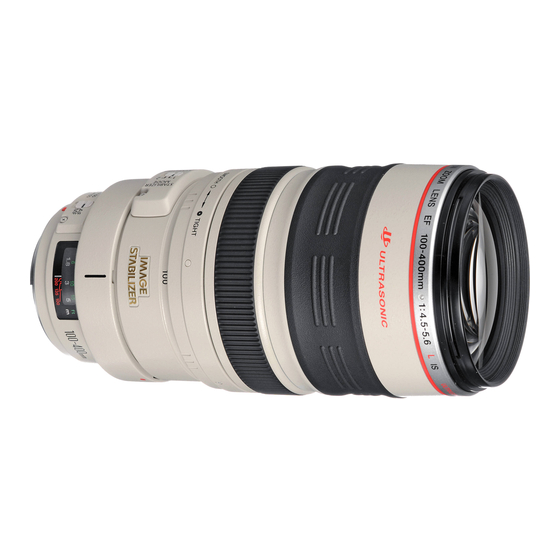
Canon EF 100-400mm f/4.5-5.6L IS USM Instruction
Ultrasonic image stabilizer ef lens
Hide thumbs
Also See for EF 100-400mm f/4.5-5.6L IS USM:
- Parts catalog (9 pages) ,
- Instructions manual (20 pages)
Summary of Contents for Canon EF 100-400mm f/4.5-5.6L IS USM
- Page 1 EF100-400mm EF100-400mm f/4.5-5.6L IS USM f/4.5-5.6L IS USM E E N N G G Instruction...
- Page 2 Thank you for purchasing a Canon product. The Canon EF100–400mm f/4.5–5.6L IS USM lens is a high-performance telephoto zoom lens for EOS cameras. ● “IS” stands for Image Stabilizer. ● “USM” stands for Ultrasonic Motor. Handling Cautions ● If the lens is taken from a cold environment into a warm one, condensation may develop on the lens surface and internal parts.
-
Page 3: Safety Precautions
a Safety Precautions a Safety Precautions ● Do not look at the sun or a bright light source through the lens or camera. Doing so could result in loss of vision. Looking at the sun directly through the lens is especially hazardous. ●... -
Page 4: Table Of Contents
Nomenclature Hood mount (→ 12) Filter mounting thread (→ 12) Zoom ring (→ 6) Focusing ring (→ 4) Image stabilizer switch (→ 7) For detailed information, reference page numbers are provided in parentheses (→ **). Zoom touch adjustment ring (→ 6) Image stabilizer mode selector switch (→... -
Page 5: Focusing Ring
1. Mounting and Detaching the Lens See your camera’s instructions for details on mounting and detaching the lens. ● After detaching the lens, place the lens with the rear end up to prevent the lens surface and contacts from getting scratched. ●... - Page 6 3. Switching the Focusing Distance Range You can set the focusing distance range to 1.8 m/5.9 ft. to infinity or 6.5 m/21.3 ft. to infinity. By setting the suitable focusing distance range, the actual autofocusing time will be shorter. If you use AF from outside the specified focusing distance range, the lens may stop focusing when it reaches the limit of the range.
-
Page 7: Zoom Ring
4. Adjusting Zooming Resistance Move the zoom ring forward or backward to zoom. ● Be sure to finish zooming before focusing. Changing the zoom ring after focusing can affect the focus. ● To prevent unintended extension of the front of the lens, be careful not to set the zoom ring too loose. - Page 8 5. Image Stabilizer You can use the image stabilizer in AF or MF mode. STABILIZER Set the STABILIZER switch to ON. ● If you are not going to use the image stabilizer function, set the switch to OFF. STABILIZER MODE STABILIZER Select the stabilizer mode.
- Page 9 6. Tips on Using the Image Stabilizer The image stabilizer in this lens is effective for hand-held shots under the following conditions. ● MODE 1 ● In semi-darkened areas such as indoors or outdoors at night. ● In locations where flash photography is prohibited, such as art museums and theater stages.
- Page 10 Tips on Using the Image Stabilizer ● The Image Stabilizer cannot compensate for a blurred shot caused by a subject that moved. ● Set the STABILIZER switch to OFF when using the camera on a tripod. If the switch is set to ON, the Image Stabilizer may introduce errors.
-
Page 11: Distance Scale
7. Infinity Compensation Mark Infinity compensation mark Distance index To compensate for shifting of the infinity focus point that results from changes in temperature. The infinity position at normal temperature is the point at which the vertical line of the L mark is aligned with the distance indicator on the distance scale. -
Page 12: Lens Mount Index
9. Using the Tripod Mount Adjusting the Tripod Mount By loosening the orientation locking knob on the tripod mount you can rotate the camera to set the image for any vertical or horizontal position. Detaching the Tripod Mount First remove the lens from the camera and then remove the tripod mount from the lens as shown below. -
Page 13: Filter Mounting Thread
11. Filters (Sold Separately) You can attach filters to the filter mounting thread on the front of the lens. ● Use a polarizing Canon filter (77mm). ● To adjust the polarizing filter, first remove the lens hood. ENG-12... - Page 14 12. Extension Tubes (Sold Separately) You can attach extension tube EF12 II or EF25 II for magnified shots. The shooting distance and magnification are shown below. Focusing Distance Range (mm) Close Long distance distance 100mm 1122 EF12 II 400mm 1569 13224 100mm EF25 II...
- Page 15 14. Extenders (Sold Separately) Lens specifications when using extender EF1.4× II/EF2× II are as follows. Item Focal length (mm) Aperture 1/3 steps 100mm 400mm 1/2 steps 100mm 400mm Angle of view Diagonal Vertical Horizontal Maximum magnification (×) ● Attach the extender to the lens, and then attach the lens to the camera. To remove it, reverse the order.
-
Page 16: Specifications
Aperture settings are specified on the camera. The camera automatically compensates for variations in the aperture setting when the camera is zoomed in or out. • All data listed is measured according to Canon standards. • Product specifications and appearance are subject to change without notice. - Page 17 CT1-7521-008 © CANON INC. 1998 2009.7...










